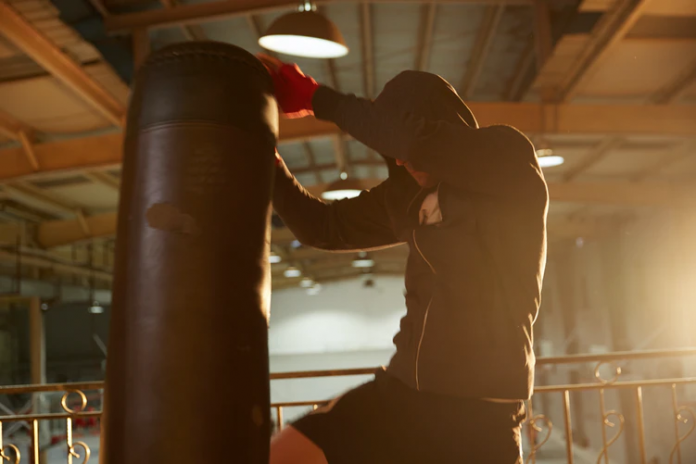The relationship between stress and aging has an immense effect on your physical and mental health.
When you’re stressed, your brain gets full of stress hormones and when this happens you lose concentration, have short term memory problems, and difficulty sleeping.
Chronic or constant stress can even lead to a lowered immune system, heart problems, vision and hearing loss, digestive and dental issues.
Why Choose a Punching Bag Workout as a Stress Reliever
Physical activities are an amazing stress reliever because of its purifying effect on stress levels.
The workout requires you to put all of your attention to it, making you forget about the reasons for your stress. And after working out, you’ll have a calm mind with a better perspective on how to deal with your problems.
While working out on a punching bag, you’ll have an endorphin production increase, meaning boosted happiness, relieved pain, and less stress. Physically, it will give you increased power, enhanced core stability and coordination, a better body shape, and improved reflexes.
Find the Perfect Punching Bag
Types of Punching Bags
Free Standing
Free standing bags are easy to move and store since they don’t need to be mounted or hung, their centers are filled with sand or water.
This is your ideal punching bag since it’s adequate for beginners and works with all-around exercises. It’s best used for mastering your low kick techniques and punches. Make sure to check out these free standing punching bags that will help you enhance your overall workout.
Heavy Bag
These are used for hard and heavy training. They are large, heavy-duty bags in different shapes and sizes that are hung from the ceiling in order to resist great impact.
Heavy bags are designed to enhance your punching techniques. Using one will improve your muscle strength and tone.
Wall Bag
This bag is best set in places with high or vaulted ceilings since they don’t have a rebound or swivel.
Wall bags are good in developing elusive skills, better power punching, and elbow strikes. Hitting it will feel similar to hitting a person because you get more feedback.
Uppercut
Unlike the majority of punching bags, uppercut bags are smaller and can either be mounted or suspended.
Although it is focused on uppercut practice, it is also a good use for straight punches.
Speedball
A speedball is often inflated and hung from a wall board or bought as a free standing bag. They are typically smaller and shaped like a teardrop.
This is ideal for beginners as it can help you perfect your hand-eye coordination, upgrade your past-faced punches and make you more reflexive.
Maize ball and bags
A maize ball may seem similar to a speed ball, they are small and often filled with rag or fake granules.
Maize balls help in building defense movies, head movement, and uppercuts.
Punching Bag Material
Leather
Punching bags are generally made of leather. Although they are expensive, this is still a popular choice because of its natural feel and durability for all around training.
Nylon
This bag material is best for stuffy places, they are good in resisting mold and their cleaning materials are cheaper.
Plastic
This is not one of the preferred materials because it’s thick and rubbery which will not give you even a close feel to a leather bag.
Canvas and Polyurethane
Canvas and Polyurethane made punching bags are amazingly durable. They’re designed for intense endurance workouts and are more affordable than leather bags.
Injury Prevention
As a senior, your age is not the best for injuries. As we grow older, our body takes longer to recover, so it’s best to avoid this situation.
Warm Up
Warm ups are essential, they ready your muscles for the activity and improve your flexibility. Warm up exercises such as jogging in place and jumping jacks are highly suggested, although squats and shadow boxing are helpful too. A two minute warm-up would be enough for an hour of workout.
Wrap Your Hands
Punching bags are heavy, and if your wrists are weak, you become injury prone so you need to be certain to protect vulnerable areas. Hand wraps are necessary to keep your hand in its shape as you throw punches.
A hand wrap or wrist tape is used to protect your wrist and fist’s bones. When you use a cotton hand wrap, make sure that you wrap your wrist three to four times to secure them.
What Boxing Gloves to Use
There’s a variety of boxing gloves available depending on how much protection you need. Since you won’t be competing, bag gloves are your best option.
Gym Bag Gloves
These look like leather mittens, they have elastic at the wrists and a leather covering the hand. Normal gym bag gloves have light padding, but there are also gloves that contain light weights to build arm strength.
Wrap Bag Gloves
These types of gloves are designed for protection, even more than what gloves normally offer. They are made of leather and have finger padding up to the fingernails that can take more pressure and impact.
Boxing-Style Bag Gloves
These are similar to boxing gloves but are heavier and with thicker padding. Its hand chambers are fully enclosed and curved while the thumb is thickly padded. They are good for a punching bag workout, especially for a heavy bag.
Combination Drills
Sadly, a punching bag workout isn’t just done by punching randomly into the bag. There are punch combinations you can do for a certain amount of time to maximize your results. Remember to rest for 15-20 seconds before proceeding to the next drill to avoid muscle strain.
Jab-Cross-Squat
Stand across the punching bag with one of your feet in front of the other. The toes of your feet should point a 45-degree angle to the bag.
Position your hands and ready them to punch. Use one of them to protect your face and the other to throw two punches. The first punch with your left arm and the second with your right and end it with a squat. After that, stand up and repeat the sequence for 45 seconds.
Cross Punches
If you are right-handed, put your left foot forward and transfer your weight to your back foot. And if you’re left-handed, do the exact opposite.
Use your dominant arm to throw a punch across while shifting your weight forward this time. Then, return your dominant arm to its position and shift your weight back.
Repeat this sequence for a full 45 seconds using only your dominant arm. Then, rest for 15-20 seconds and repeat the sequence again but using your non dominant arm this time.
Lunge-Kick-Jab-Cross
Stand a leg length away from the bag. Use your right foot to step backward and do a reverse lunge. Right after the lunge, stand up and shift your weight to your left foot.
Swing your right knee in order to do a kick using your heel. Then bring it back to the starting position and throw four cross punches. Next, switch sides and do the reverse lunge and front kick with your left leg before performing four cross punches again. Note: if your shins get sore easily, check out the shin conditioning techniques here.
Repeat this sequence for 45 seconds.
Hooks
Start by putting your dominant foot back and turning your front foot in a 45 degree angle. Lift your back heel while bringing your hands to your face and twist your hip forward. Before swinging your dominant hand to punch the bag, pivot your back foot.
Repeat this sequence with your dominant hand for 45 seconds. After that, rest for 15 seconds before repeating it using your non-dominant hand.
Things to Keep in Mind
Your Physical Health
Your overall physical health is the most important thing when working out, especially because punching bag workouts affect all of your muscles.
Having a protein shake an hour before your workout and eating about 150 grams of carbohydrates a day is the key to having a good recovery. Your sleep is important too in order to ease your training. Make sure that you sleep 7-9 hours every night before doing this workout.
After the workout, take a few minutes of rest. When the tension leaves your body, drink enough water and stretch mildly.
The Proper Techniques
If you think that punching as hard as you can or as long as you can is maximizing the benefits of your workout, then you’d be surprised to know it will only increase injury risk and slow your progress.
Never hold your breath just to exert a certain amount of force. Your breathing will help you stay relaxed and lessen exhaustion. Remember to exhale after throwing a punch to guarantee your muscles a continuous supply of oxygen.
In a punching bag workout, you throw punches to the bag and not throw yourself to it. Balance yourself by planting your feet. Your balance just like your distance will help you exert more power and more control.
Avoid pushing the bag or making it swing, the only thing you need to do is hit it. To prevent your arms from getting tired too quickly, never make too much contact. After throwing a punch, immediately return your fist to its starting position. If you’re doing it correctly, you’d be hearing a smack for every punch or kick you do instead of a thud.
Author Bio:
Jake Willhoite
Jake is the head fitness fanatic and editor in chief over at HealthListed.com. You’ll often find him researching new workouts or listening to his favorite health podcasts.






















